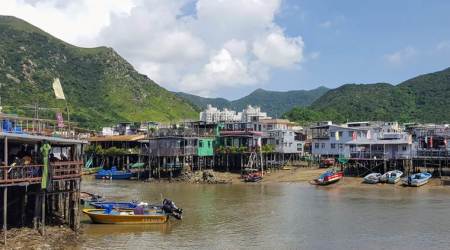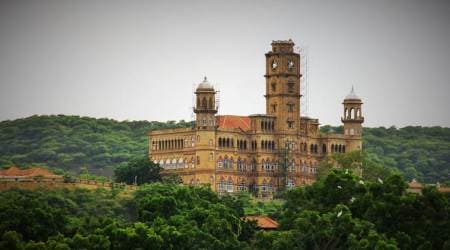 Shades of life: Works by Manu Parekh — Banaras, acrylic on canvas, 2011.
Shades of life: Works by Manu Parekh — Banaras, acrylic on canvas, 2011.
The show brings together 60 years of your work. It must be both exhausting and nostalgic to curate such a huge exhibition on your own.
It is nostalgic, but also very exciting. I thought it was best to curate it myself as I know my work best. I have never been attached to any specific gallery and always preferred to work independently. This way, I was free to experiment. When I felt I was becoming too comfortable with one style, I changed it. I tried different mediums — painting, sculptures, used board and cement to give the impression of a wall graffiti. Most of my exhibitions have been at Jehangir Art Gallery in Mumbai and the Lalit Kala Akademi in Delhi. When my show used to get over at Jehangir, I used to book for the next. One usually got a space only after three years. With this exhibition, my aim is to give the viewers a sense of what all I have done. The focus is not on design, but on the variation.
The exhibition features your works from the early ’60s — right after you finished studying art at Sir JJ School of Art in Mumbai.
There are around 50-60 works from that period. These were with me and this is the first time I am exhibiting them. You see a lot of influences from that period — from Indian folk to Paul Klee and Indian miniature, which used to be part of our curriculum at JJ School, when I was studying there under Shankar Palsikar. It was a very good practice — by reproducing miniatures we learnt the linear elements better. I used to admire the works of Paul Klee and thought it was very Indian. I realised much later that was because of his interest in theosophy. I remember as a student when I was asked to reproduce Michelangelo, I used to be very frustrated and wonder why. Coming from a middle-class background, I could not relate to him or his subjects.
You were also actively involved in dramatics when you were a student in Mumbai. Could you tell us a bit about that phase? Did that affect your art?
We used to participate in many inter-college theatre competitions when I was in JJ School and that’s how I got initiated into theatre. Gradually, I started doing professional theatre to make some money. Tarak Mehta was my first director. Later, when I went to Ahmedabad, I joined the Indian People’s Theatre Association and worked with Dina Pathak. I acted and designed the sets for a Gujarati translation of Rabindranath Tagore’s play Muktadhara. Initially, I wanted to pursue both theatre and art, but had to take a full-time job. It was difficult to manage three things, so I had to quit theatre. It was very tempting, but there was no choice. What I learnt during those few years has helped me immensely in the way I paint the expressions of my subjects. For instance, in my rendition of The Last Supper in this exhibition, I have focussed on the faces of the characters; there are no arms, legs, just the face and that is supposed to reflect their emotions, the situation. In India, heads are particularly significant, considering the number of people we encounter every day.
 Flower from Heaven, another acrylic on canvas, 1995.
Flower from Heaven, another acrylic on canvas, 1995.
You worked in the All India Handloom Board, followed by the Handicraft Handloom Export Corporation for more than 20 years. That has certainly had an impact on your art.
In the ’60s, when I joined the handloom corporation, Pupul Jayakar was its head. She had decided that she will only hire artists and not designers, which is why many of us, including Arpita (Singh) and Jeram (Patel), worked there. When I joined, KG Subramanyan had just quit, but he was working on three projects in Mumbai. Observing him handle those projects was a great learning experience for me. I had taken the job for only two-three years, but had to continue for longer. I travelled across India for work, deep into the villages of Odisha, Madhubani, Bihar, and Rajasthan, to create new textile patterns with the rural craftspeople. I never tried to introduce my own patterns — my aim was to use indigenous materials and design. Some of my prominent projects were in the Bagru village in Rajasthan, the national collection of saris from Odisha and promotion of Madhubani paintings through the Harijan project, which carried forward the work done by Bhaskar Kulkarni. I think the ground-level work we did in the ’70s and ’80s, is benefitting the current generation of designers, too.
We see a lot of influence of the city you lived in, in your work. You almost seem to have a colour palette for each place — Gujarat is bright, Kolkata is more muted. Was that deliberate?
When I was in Mumbai, I did not like it a lot. I felt it was a city for successful people, but when I was posted in Kolkata, within a week I became a Kolkatan. I loved the energy of the city. I used to see a lot of Bengali films, so I was familiar with the city on screen, but this was different. I remember I used to travel in tram number 24, and the sights I saw on the way, the dingy walls, pipes running everywhere, its Durga Puja festivities, all stayed with me. My colour scheme immediately became darker. An organic period of art began. I also became a member of the Society for Contemporary Artists within six months. I was only 25-26 when I went there, but I stayed there for 10 years.
 The artist.
The artist.
What about Varanasi? So many artists have painted the city, including Ram Kumar and MF Husain, but the Varanasi you paint is darker, more mystical in some ways.
I first went to Varanasi after my father’s death in 1980, and have revisited it several times. At that time, I was posted in Delhi and I did not like it at all. It was like coming from a dark, dingy box (Kolkata) to a garden. I just did not know what to do; I could not paint or even draw. I needed some inspiration and found that in Varanasi. It was organic, like Kolkata, and, bustling with people. In the spiritual atmosphere, even a simple thing was mystical. For instance, the flowers weren’t just beautiful objects, but travelled from the idols to the water and the streets. There are so many layers and contradictions. One evening, when I was on a boat, the sky turned red and the setting sun was reflected in the water, the temple bells were ringing — it was an experience I can never forget.
You have often said that two of your biggest inspirations have been Rabindranath Tagore and FN Souza, but their work is dramatically different. How have you imbibed influences of both?
It’s Souza’s carefree brush strokes and Tagore’s very Indian landscapes that I admired. Even though I was born in Ahmedabad, I read Tagore voraciously from an early age. To me, he was also a great painter. When I was in Kolkata, I visited Santiniketan a few times. I took inspiration from the Progressive Artists’ Group (PAG) and the Bengal school of art. I think one of the biggest blunders in Indian art history is that the members of the PAG pronounced that the Bengal school was very weak. They brought in Western influences, bohemian elements, but, the fact is, that the Bengal school was deep-rooted; look at Nandalal Bose’s wash technique or Ramkinkar Baij or Benode Behari Mukherjee’s drawings — they are so powerful. I think KG Subramanyan played an important role in bridging the gap between the two schools of thought. He was based in Baroda and Mumbai and he built respect for the Bengal school.
Your daughter Manisha is an artist and your wife Madhvi often says you were her art teacher. Do you turn to each other for suggestions and criticism?
I got engaged to Madhvi when she was nine and I was 12. We got married when I was 18 and she was 15, but we did not stay together for five years. I was in JJ School, she was also studying. She was not formally trained in art, but, gradually, I initiated her. We follow completely different styles. I show my work to both Madhvi and Manisha. The current generation has much more exposure and is more critical. I always tell Manisha that my generation is much more appreciative; their generation is more critical.

